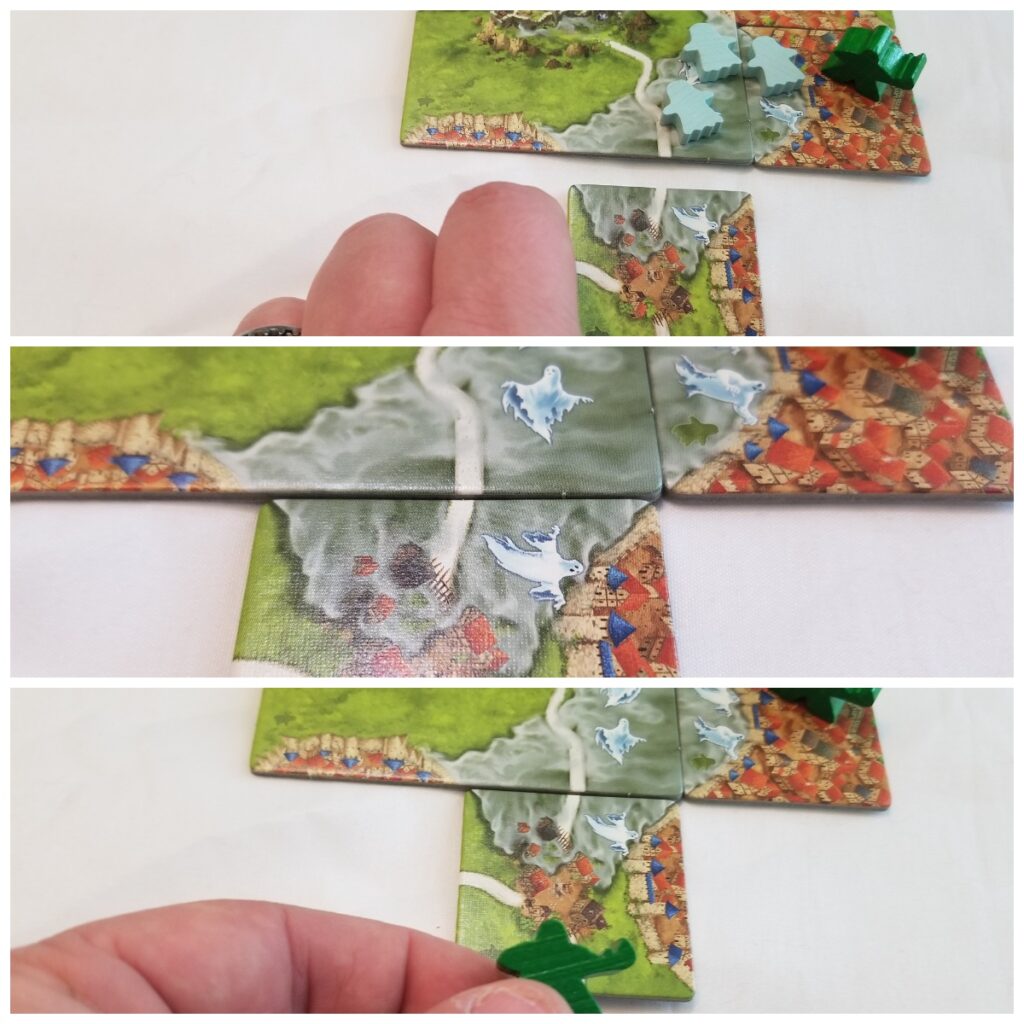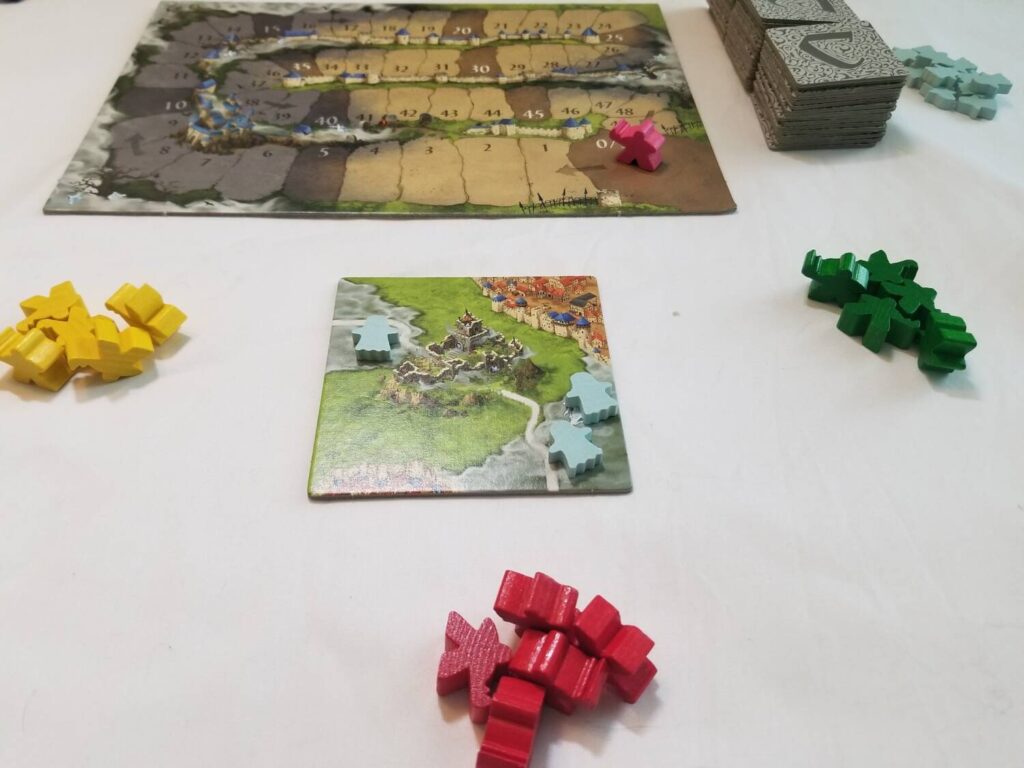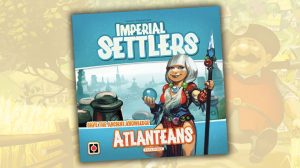Ever since I was first introduced to Carcassonne way back in 2002, I have been addicted, eagerly gobbling up and incorporating every expansion, mini-expansion, and promo that I can get my hands on. I distinctly remember a point in time when a game of Carcassonne only took 30 minutes to an hour. Now, it’s an all-day affair.
There are times when I miss that rapid-fire gameplay, and I suppose I have nobody to blame but myself. There’s no rule that says I absolutely have to play with everything every single time that I play, but the temptation is too hard to resist.
And that’s why standalone Carcassonne games like Hunters & Gatherers, South Seas, and the subject of this review—Mists Over Carcassonne—are so important (at least to me). Firstly, they serve as out-of-the-box game experiences that allow me to enjoy playing Carcassonne without having to spend time separating tiles into their various expansions. Secondly, they serve as potent reminders that Carcassonne isn’t just a game. It’s a game system. With just a few slight tweaks to the rules and a couple of extra components, it’s almost like you’re playing a brand-new game. One version of Carcassonne may just provide you with new avenues to explore to earn more points, while others give you interesting ways to interact with your opponents to hinder their plans or hone in on their hard work to reap the rewards.
In the case of Mists Over Carcassonne, you get a little bit of both worlds—a stand-alone cooperative Carcassonne experience that constructs a new experience using the scaffolding of the base game’s familiar rules, but it also functions as an expansion to the base game, presenting new opportunities to hinder your opponents. Played one way, it’s a friendly game. Played the other way, it’s pure aggression. It is an interesting dichotomy for sure.
This review is going to focus mainly on the cooperative experience (because, honestly, that’s why we’re really excited about this game, right?), but I will briefly describe how it can be used as an expansion a bit later.
How It’s Played
Mists Over Carcassonne (MoC) is played over a series of 7 progressively difficult levels, with each new level presenting new challenges for the players to overcome.
MoC is composed of 60 tiles, only 50 of which will be used in Level 1. The turn structure and the placement of the tiles follow the rules of the base game—roads connect to roads, fields to fields, and city pieces to city pieces. Almost every tile contains mist, and most of those feature some number of ghosts. These changes are the heart and soul of the game.

If a mist tile is placed and there are any number of ghosts printed on it, then that number of ghosts is added from the supply to the tile, with two exceptions:
- If the tile extends the mist area on another tile (mist connected to mist), then one fewer ghost is added to the tile
- If the tile should cause an existing area of mist to become entirely enclosed, then no new ghosts are added and the existing ghosts in that mist area are added back to the supply
The Goal
Level 1 of MoC has but one goal, to reach 50 points (marked by a special Goal token placed onto the 50 spot on the scoring track) before one of the game’s two end conditions are triggered. If the goal is reached, you win. If not, you lose. These two end conditions are: being required to place a ghost but having none in the supply and being required to draw a new tile and having none in the supply.
It sounds a lot easier than it is.

The game begins with the Starting tile in play (a tile designed specifically for this game). It’s a large tile (4 tiles in size, to be exact) that features three ghosts on it. So, before you even begin playing, one-fifth of the total amount of ghosts in the game are already in play. Then, it’s highly likely that you’ll find yourselves drawing runs of mist tiles that you cannot connect to any others. What started out as something manageable quickly becomes nightmarish.

Fortunately, the players have a couple of potent arrows in their collective quiver. Firstly, instead of scoring the points from a feature, the scoring player can opt to give up those points to return up to 3 ghosts from a single tile back to the supply. Secondly, in MoC, the players share a single scoring pawn. If a feature is scored and two or more players happen to be on it, that feature scores multiple times.
Level 2 introduces two new tile types: castles and cemeteries. Along with these, it presents a new target victory point condition. This time, the players must score a total of 75 points in order to advance. Here’s how the castles and cemeteries work:
Castles score like monasteries score in the base game: they don’t score until they are completely surrounded by other tiles. Unlike monasteries, castles only score points—two, to be exact— for every tile, including themselves, that have mist printed on them. Castles are useful for sure, but it takes a lot of planning, cooperation, and a little luck to benefit from them.

Cemeteries are the antithesis of useful. In fact, they will quickly become the bane of your existence. If a cemetery is in play, then any time a ghost would be placed elsewhere, you must place an additional ghost on a cemetery of your choice. It is possible to close off a cemetery— releasing all of the ghosts contained therein back to the supply—by surrounding it on its edges with other tiles. But, when a cemetery is closed off in this way, the players have to place one of their meeples that are in play into the cemetery, where it will become unusable for the rest of the game.

Apparently, the only way to appease the dead is with more death or something.
But Wait, There’s More
If you thought that was hard, Level 3 tasks you with scoring 100 points in order to win.
Thankfully, beginning with Level 3, the players have one more weapon in their arsenal: the hounds. There are two hounds in the game, which are used to mark certain scoring breakpoints. In Level 3, there’s a hound on the 15th space and the 50 space. When you reach, or pass, a hound on the scoring track, the hound is added to any one of the tiles containing a meeple. Then you pick any two tiles surrounding that meeple (including the tile the meeple is on) and remove up to 3 ghosts from each of them.
That hound remains with that meeple until whichever feature that meeple is sitting on scores. After scoring the feature, then the hound scores 1 point for every ghost that is currently in play, before being removed itself.
But that’s not the only new mechanic Level 3 introduces. The setup for Level 3 requires the players to separate all of the tiles into stacks of 20 each. You must reach the first breakpoint before the first stack runs out. If you do, you get the hound and you get to add the remaining tiles from that stack to the second stack. If you do not, you lose the game. The same goes true for the second stack. You must reach the second breakpoint before that stack runs out or you lose the game.
The remaining levels—Level 4 through Level 7—each tweak this formula in some small, but significant way. The breakpoints are further apart. The points needed to win become greater. The number of ghosts are reduced and the ghosts that are left enter the game at a more accelerated rate. Cemeteries become more deadly. Tiles start getting removed at random.
In short, it’s hard y’all.
Thoughts
As a die-hard Carcassonne fanatic, I knew that Mists Over Carcassonne was something that I wanted to desperately needed to play. I love Carccassonne and I want to share that love with everyone I know. But that comes with its own problems.
I’ve been playing the game for a long time and, humblebrag, I’m pretty good at it. It’s hard not to be with hundreds of games under my belt. Holding back is not in my nature. So, when I am introducing someone new to the game, they tend to get crushed. Some can see the promise in the game and relish the challenge of getting good enough to compete with me (if not outright beat me). But there are some who remember that feeling of getting slaughtered and never come back. While bringing people into the Carcassonne—and, by extension, board game—fold excites me, it fills me with an immeasurable sadness knowing there are some that I may have inadvertently chased away.
Mists Over Carcassonne solves that problem for me. The beautiful simplicity that is Carcassonne is on full display. The basic rules and concepts are easy to grasp. It’s easy to see how tweaking the formula even just the slightest bit can drastically change the game’s nature, making it almost seem like an entirely different game. I can help other players strategize without them feeling like I am critiquing them or outright telling them how to play. And MoC even sneakily teaches players the rules of weaseling their ways onto other players’ features by making the practice something to be revered and celebrated rather than something that is reviled and hated.
And it does all of this in a way that’s extremely challenging, even to the most seasoned of players. You will be tested. You will lose over and over again. If you consider yourself a Carcassonne wizard, you will be humbled. Mists Over Carcassonne takes no prisoners.
While that description might make Mists Over Carcassonne sound like misery in a box, I assure you it isn’t. Unlike Ghost Stories (another popular ghost-based cooperative game), which kicks you in the teeth right out of the gate and never lets up until you end the game in miserable defeat an hour later (can you tell I’m not a fan?), Mists Over Carcassonne plays very quickly. When you lose, the margins are thin and it always feels like you were on the verge of claiming victory from the jaws of defeat were it not for one bad tile draw or one poorly made decision. And, when you win, it feels amazing.
I know it sure felt amazing when my wife and I, after nine losses in a row at Level 2, were finally able to progress to Level 3. We strode confidently into Mists Over Carcassonne’s lair and quickly realized that the tricks we’d learned in competitive Carcassonne didn’t apply. Lessons were learned, but there were also a lot of lessons unlearned. Each loss only served to spurn us into trying again, often several times in a row. And, with each redoubled effort, we got better and better at working as a team.
It’s a glorious cooperative game.
And, as mentioned earlier, it’s also an expansion.
Played as an expansion, players have the opportunity to use ghosts to haunt their opponents’ meeples, causing them to score negative points and potentially even flee the features they’ve been placed on outright. Cemeteries earn you additional meeples when they are scored. Castles score in the exact same way as they do in the cooperative game. And, played as an expansion, the mist tiles can be used to divide fields, potentially cutting off your opponents’ farmers from scoring points and/or allowing you to score points of your own.
That’s a lot of bang for your buck.
Now, I’ll be honest: I cannot speak to what Carcassonne is like using MoC as an expansion. I’ve been having too much fun playing the game cooperatively to break out the base game to start mixing things. But I’m excited to try.
And I’m excited to reach Level 5. Maybe it’ll happen someday.
Maybe even today.
Fingers crossed.












I, like you, have a lot of Carcassonne in my game collection.
I, unlike you, would be horrified at the idea of trying to incorporate all of it into a single game. <>
My wife, friends, and I have whittled down the myriad choices of Carcassonne expansions and such into what we call our ‘Standard Play Set.’ The box containing the ‘Standard Play Set’ is segregated from the other options, expansions, and tiles of the game. That is the set we typically enjoy (perhaps with one other expansion added, if we are feeling frisky).
That said, the people I play most with all tend to agree that ‘Hunters and Gatherers’ is our favorite stand alone version of the game. We play with one house rule (when you play a bonus tile with an Auroch, you get a bonus turn). We love that version and plays of that have outstripped plays of the the ‘Standard Play Set’ recently.
All of that is to say that my wife loves cooperative games. That means I need to look for a copy of this and see how a cooperative game of Carcassonne might re-ignore the fire for the game.
Thanks for a wonderful review.